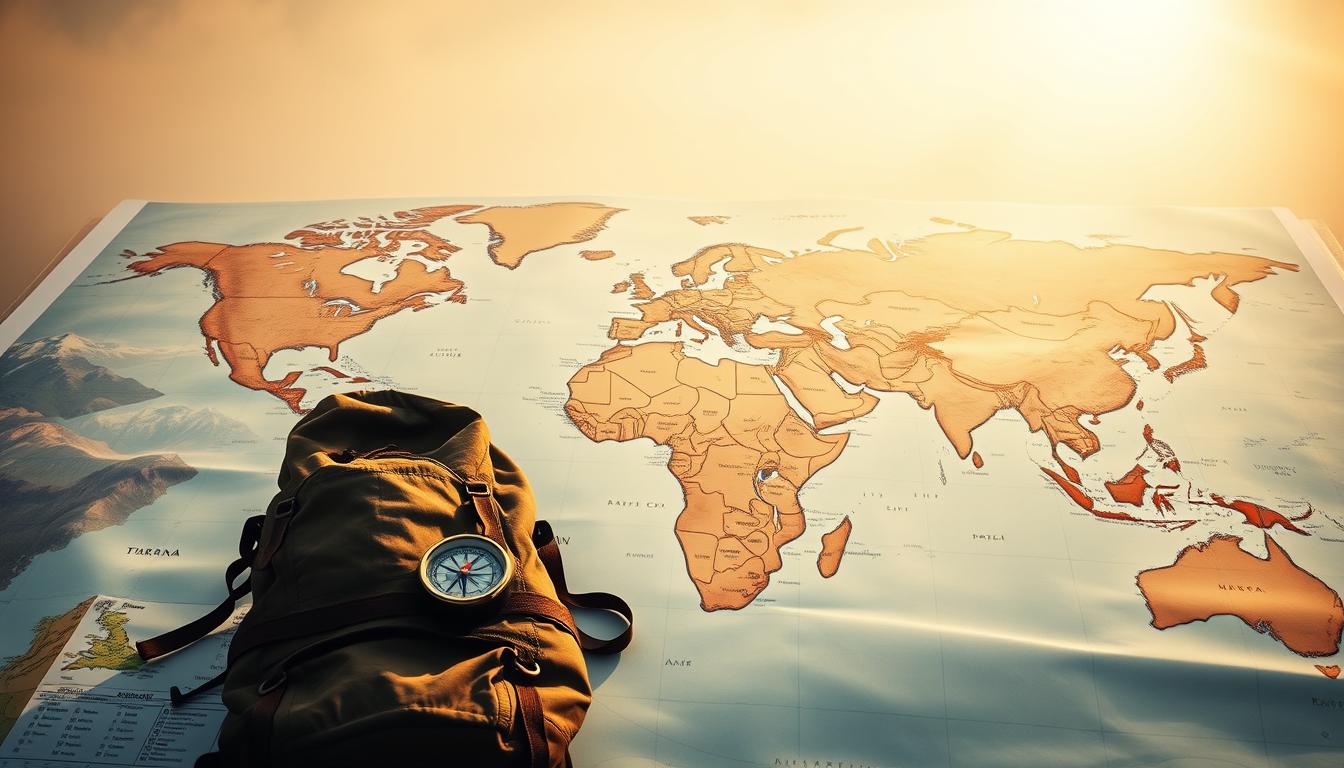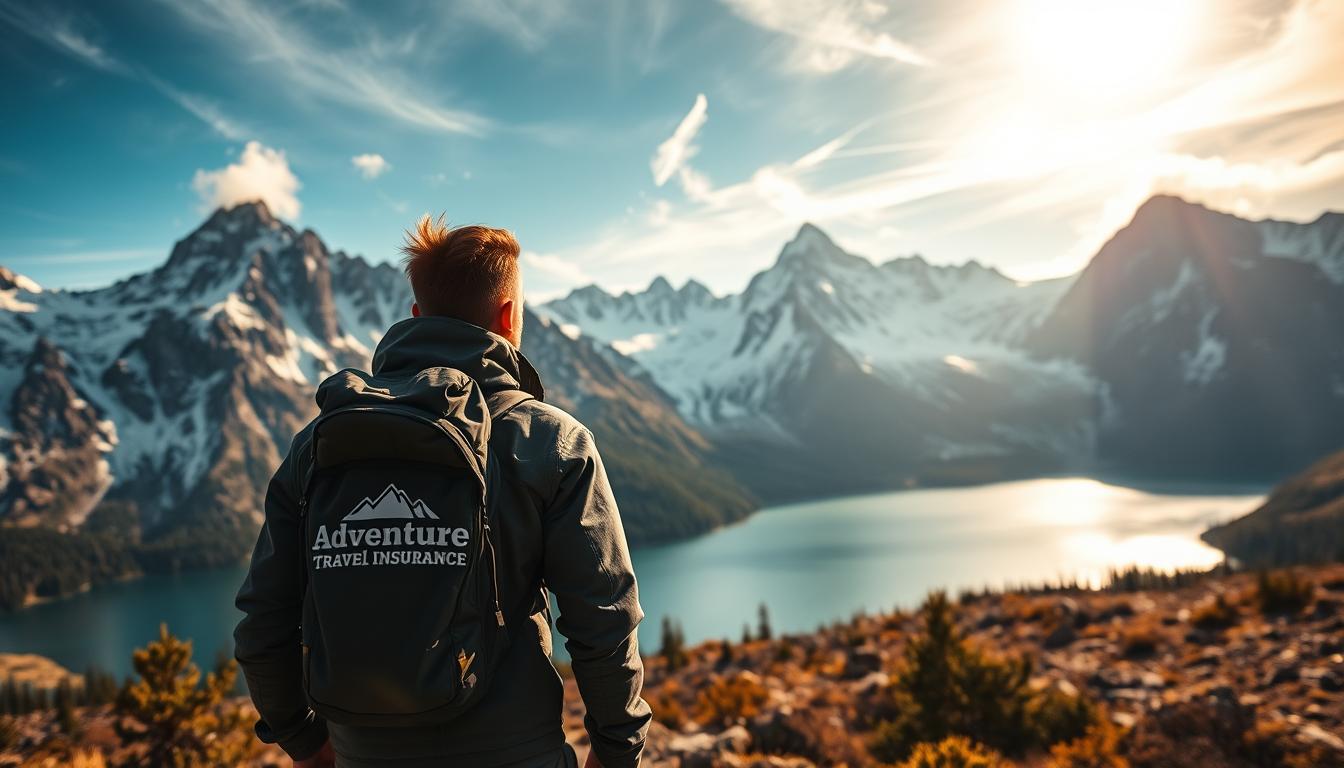Thrill-chasers know the rush of skydiving or exploring coral reefs. But here’s the catch: standard policies often exclude these activities. Did you know 72% of scuba divers and 68% of rock climbers aren’t fully covered by basic plans? That’s where specialized protection comes in.
Think of this guide as your trail buddy for navigating coverage gaps. We’ve helped hundreds balance adrenaline-packed itineraries with smart safeguards. Whether you’re heli-skiing or jungle trekking, the right plan acts like a safety harness – invisible until you need it most.
Many don’t realize standard medical policies cap evacuation costs at $25k, while real-world rescues often exceed $100k. Specialized options cover gear loss, activity-related injuries, and even trip interruptions caused by weather. We’ll break down what to prioritize based on your bucket-list destinations.
Ready to explore freely without financial worries? Let’s unpack how to match your wanderlust with bulletproof protection.
Why Adventure Travel Insurance is Essential for Extreme Sports
Picture this: you’re scaling a granite cliff when sudden weather forces an unplanned descent. While extreme sports like mountain climbing and scuba diving offer unmatched excitement, their unpredictability creates unique challenges. A 2023 Outdoor Industry Report found 42% of backcountry skiers experience injuries requiring medical care, with helicopter rescues averaging $120,000 per incident.
Hidden Dangers in High-Octane Activities
Even “safe” adventures carry hidden costs. Skydiving boasts a 0.006% fatality rate, but non-fatal injuries occur in 1 of every 1,000 jumps. Decompression sickness affects 1 in 500 recreational divers annually. Standard travel insurance policies often exclude these scenarios, leaving enthusiasts vulnerable to six-figure medical bills.
When Risks Become Financial Burdens
Consider these real-world impacts:
- Broken equipment during alpine expeditions: $8,000+ replacement costs
- Emergency surgery abroad: $35,000 average without coverage
- Legal fees from accidental property damage: $15,000 minimum
We’ve seen clients face $200k+ bills after untreated altitude sickness escalated to organ failure. Always verify your policy explicitly lists activities like ice climbing or cave exploration. Look for plans covering gear loss, rescue operations, and treatment at specialized facilities.
Understanding Travel Insurance for Adventure Seekers
Securing the right safeguards lets you focus on the climb, not the “what-ifs.” Specialty insurance policies differ from basic plans by covering activities standard options often exclude. Let’s unpack what’s included – and what might surprise you.
What’s Usually Protected?
Top travel insurance companies like World Nomads cover 200+ activities when you add sport upgrades. Common inclusions:
| Activity | Standard Policy | Specialized Plan |
|---|---|---|
| Scuba Diving | Excluded below 30m | Covered to 40m |
| Parachuting | Not covered | Included with license |
| Mountain Climbing | Up to 4,500m | All altitudes |
| Equipment Loss | $500 limit | $3,000+ protection |
Where Plans Fall Short
Even upgraded policies have limits. Travel Guard excludes backcountry skiing more than 3 miles from resorts. Many companies won’t cover:
- Competitions or races
- Activities while intoxicated
- Extreme weather risks you ignored
Always check the details – some plans require guides for certain sports. We recommend comparing multiple travel insurance companies to match your itinerary. Your equipment deserves specific coverage clauses too, especially for high-value items like climbing gear.
Key Coverage Areas for Adventure Travel Policies
Imagine your dream expedition gets canceled last minute. Now you’re facing $5,000 in non-refundable deposits. Comprehensive protection plans act like financial airbags – absorbing impacts so you can pivot safely. Let’s explore three pillars every thrill-focused policy needs.

Trip Cancellation and Interruption Benefits
Non-refundable deposits become recoverable when unexpected events strike. Valid claims include:
- Sudden illness (with doctor’s note)
- Severe weather halting flights
- Political unrest at your destination
A 2023 study showed 83% of climbers recovered 90% of costs when Kilimanjaro routes closed due to wildfires. Always check coverage limits – top plans reimburse up to $20,000.
Emergency Medical Evacuation and Medical Expenses
Helicopter rescues from remote peaks average $120,000. Quality plans cover:
- Air transport to trauma centers
- Surgery costs abroad
- Follow-up care at home
When a client broke their pelvis trekking Nepal’s Annapurna Circuit, their emergency medical evacuation coverage handled the $95,000 helicopter bill. Verify your policy includes $500k+ for medical expenses – serious injuries often require multiple surgeries.
Baggage and Personal Item Protection
Lost gear can derail expeditions faster than a snapped rope. Look for:
- $3,000+ equipment replacement
- Same-day reimbursement for essentials
- Coverage for rented items
One mountaineer recovered $8,200 after airlines misplaced their climbing kit in Patagonia. Pro tip: Photograph high-value gear and keep receipts for faster claims.
Selecting the Right Policy and Add-Ons for Your Adventure
Navigating coverage options feels like prepping for a summit – choose wrong, and you’re exposed. Base plans from most companies work like basic climbing gear, while specialized options act as technical safety systems. Let’s map your route to protection that matches your ambition.
Comparing Base Policies with Adventure-Specific Options
World Nomads’ standard package covers 100+ activities, but their Explorer upgrade adds heli-skiing and cave diving. Battleface includes high-altitude climbing in base plans, while Tin Leg requires adding a “Weather Extreme” rider for storm-related cancellations. Key differences:
- Medical limits: $100k (standard) vs. $500k (adventure)
- Gear coverage: $300 vs. $3,000+
- Rescue zones: Within 50 miles vs. global
Travel Guard’s base plan excludes backcountry skiing – a $29 add-on fixes this. We’ve seen groups save 15% by bundling specialized coverage for shared expeditions.
Optional Add-Ons for High-Risk Activities
Treat add-ons like carabiners – each serves a specific purpose. For bungee jumps, Battleface’s “Extreme Sports” package covers equipment failure. Tin Leg’s “Polar Upgrade” protects Antarctic kayakers against frostbite-related claims. Follow this checklist:
- List every activity (even “optional” ones)
- Compare benefit caps across three providers
- Verify guide requirements
- Check weather exclusion clauses
One client avoided $12k in costs when World Nomads’ “Gear Shield” covered their stolen avalanche kit. Remember: Cheapest isn’t best when dangling from a rope. Licensed agents spot gaps faster than any algorithm – use their expertise.
Real-Life Scenarios and Lessons from Adventure Travel
Picture a team stranded on Antarctica’s ice sheets after equipment failure. Their adventure travel insurance covered $150k in evacuation costs – a real 2022 case handled by Trawick International. These stories prove why smart preparation matters.
Case Studies from Extreme Sports Incidents
A diver exploring Thailand’s reefs faced $28k hospital bills for decompression sickness. Their policy covered hyperbaric chamber treatments after proving certification. Key lessons:
| Incident | Costs | Policy Response |
|---|---|---|
| Backcountry Ski Fracture | $94k rescue | Covered 100% |
| Climbing Gear Theft | $6,200 loss | 80% reimbursed |
| Altitude Illness | $47k treatment | Paid after deductible |
Berkshire Hathaway’s data shows 73% of ski injury claims get full payouts when filed correctly. Always document incidents with photos and witness statements.
Insights and Advice from Industry Experts
“Policies work best when they match your exact travel activities,” says Mara Simmons of Trawick International. Her team helped a client recover $12k after volcanic ash canceled a Patagonia trip.
Three rules from pros:
- Verify coverage depth for repetitive activities (like multi-day dives)
- Choose providers with 24/7 emergency teams
- Update policies when adding new sports
One family avoided $18k in costs when their plan covered malaria treatment during an African safari. Your turn: Review last year’s trip – would you have been protected?
Conclusion
Your next expedition deserves more than luck—it needs a safety net that understands adrenaline-fueled journeys. The best travel insurance acts like a trusted guide, matching your exact activities while shielding you from unexpected risks.
We’ve seen how proper coverage turns potential disasters into manageable bumps. Always verify policy limits for gear replacement and evacuation costs—real-world rescues often exceed $100k. Compare multiple plans to find one covering your destination’s unique challenges.
Three rules from our experience:
1. Document every activity, even optional ones
2. Prioritize plans with 24/7 emergency support
3. Review exclusions thoroughly—twice
Investing time now prevents financial avalanches later. With the right policy, you’ll focus on summits rather than spreadsheets. Ready to explore smarter? Let’s make your next adventure both thrilling and secure.
FAQ
Are extreme sports like rock climbing covered under standard policies?
What happens if I need emergency evacuation from a remote area?
Does coverage include gear rentals or equipment damage?
FAQ
Are extreme sports like rock climbing covered under standard policies?
Most basic plans exclude high-risk activities, but companies like World Nomads and IMG offer adventure-specific policies. Always verify if your activity (e.g., ice climbing or paragliding) is listed as covered.
What happens if I need emergency evacuation from a remote area?
Many specialized plans include emergency medical evacuation, which coordinates transport to proper facilities. Companies like Allianz often cap this benefit between 0k–0k, depending on your destination’s risk level.
Does coverage include gear rentals or equipment damage?
Some policies reimburse repairs for damaged gear—like scuba tanks or ski bindings—if theft or loss occurs during transit. Check limits (often
FAQ
Are extreme sports like rock climbing covered under standard policies?
Most basic plans exclude high-risk activities, but companies like World Nomads and IMG offer adventure-specific policies. Always verify if your activity (e.g., ice climbing or paragliding) is listed as covered.
What happens if I need emergency evacuation from a remote area?
Many specialized plans include emergency medical evacuation, which coordinates transport to proper facilities. Companies like Allianz often cap this benefit between $100k–$500k, depending on your destination’s risk level.
Does coverage include gear rentals or equipment damage?
Some policies reimburse repairs for damaged gear—like scuba tanks or ski bindings—if theft or loss occurs during transit. Check limits (often $1k–$3k) and whether rentals are included under “personal item protection.”
Can I get reimbursed if my trip is canceled due to weather?
Trip cancellation benefits usually apply if severe weather disrupts flights or lodgings. However, last-minute changes for “ideal conditions” (e.g., perfect surf forecasts) typically aren’t covered unless specified in add-ons.
Are pre-existing medical conditions excluded from adventure plans?
Many providers exclude them, but companies like Safety Wing offer waivers if you purchase coverage within 14 days of booking your trip. Disclose conditions upfront to avoid claim denials.
How do I prove the value of lost specialty equipment?
Keep receipts, photos, or appraisals for high-cost items like cameras or climbing gear. Some insurers require police reports for theft claims or proof of purchase for reimbursements over $500.
Do policies cover activities like ice climbing or cave diving?
It varies. For example, World Nomads covers over 200 activities, while others require add-ons. Review the policy’s “adventure sports activities” list—if unsure, call the provider before buying.
What’s the difference between base policies and adventure-specific ones?
Base plans focus on basics like trip delays or minor injuries. Adventure upgrades add coverage for gear loss, emergency rescue, and high-risk sports. Compare options from providers like Travelex for tailored fits.
k–k) and whether rentals are included under “personal item protection.”
Can I get reimbursed if my trip is canceled due to weather?
Trip cancellation benefits usually apply if severe weather disrupts flights or lodgings. However, last-minute changes for “ideal conditions” (e.g., perfect surf forecasts) typically aren’t covered unless specified in add-ons.
Are pre-existing medical conditions excluded from adventure plans?
Many providers exclude them, but companies like Safety Wing offer waivers if you purchase coverage within 14 days of booking your trip. Disclose conditions upfront to avoid claim denials.
How do I prove the value of lost specialty equipment?
Keep receipts, photos, or appraisals for high-cost items like cameras or climbing gear. Some insurers require police reports for theft claims or proof of purchase for reimbursements over 0.
Do policies cover activities like ice climbing or cave diving?
It varies. For example, World Nomads covers over 200 activities, while others require add-ons. Review the policy’s “adventure sports activities” list—if unsure, call the provider before buying.
What’s the difference between base policies and adventure-specific ones?
Base plans focus on basics like trip delays or minor injuries. Adventure upgrades add coverage for gear loss, emergency rescue, and high-risk sports. Compare options from providers like Travelex for tailored fits.


